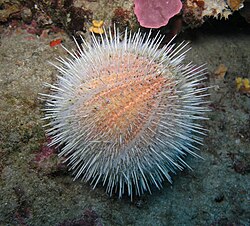| Echinacea Temporal range: | |
|---|---|
 | |
| Echinus melo | |
| Scientific classification | |
| Domain: | Eukaryota |
| Kingdom: | Animalia |
| Phylum: | Echinodermata |
| Class: | Echinoidea |
| Infraclass: | Carinacea |
| Superorder: | Echinacea Claus, 1876 |
| Orders | |
(See text) | |
The Echinacea are a superorder of sea urchins. They are distinguished by the presence of a rigid test, with ten buccal plates around the mouth, and solid spines. Unlike some other sea urchins, they also possess gills. The group is a large one, with species found worldwide.




